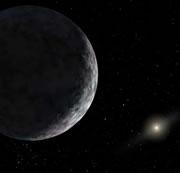 Eris is heavy — but that doesn't make it a planet.NASA/JPL-Caltech
Eris is heavy — but that doesn't make it a planet.NASA/JPL-CaltechWhether you call it a planet or not, Pluto has officially been overtaken by a more massive planetary object — Eris (previously nicknamed Xena).
Pluto, traditionally known as the ninth planet of our Solar System, sits in a giant zone called the Kuiper belt that is filled with asteroids and many other planetary bodies. The discovery of more and more objects in this zone — including Eris, in 2005, which was found to be bigger than Pluto — led astronomers to try to more strictly define what is and isn't a planet. In 2006, members of the International Astronomical Union (IAU) at a meeting in Prague, the Czech Republic, voted that Pluto be reclassified as a 'dwarf planet'. Eris, by these terms, sits in the same category.
Now the notion that Eris is a hefty competitor to Pluto has been backed up with a measurement of the object's mass. Michael Brown, who discovered the planet, and Emily Schaller, both from the California Institute of Technology, Pasadena, say that Eris weighs in at 16.6 billion trillion kilograms. That makes it the most massive dwarf planet seen yet, and 27% more massive than Pluto.
The figure, reported in Science1, was calculated using measurements taken by the Hubble Space Telescope and the Keck Observatory of Eris's moon Dysnomia circling the planet. From these, Brown and Schaller first worked out that the moon takes about 16 days to orbit Eris. Kepler's laws of planetary motion, and models detailing the gravitational pull between two objects, then reveal the planet's mass.
Wide load
The radius of Eris was measured previously by Frank Bertoldi, from the Max Planck Institute for Radioastronomy in Bonn, Germany. He found it to be about 3,000 kilometres across — about a third wider than Pluto. But getting a value for the mass is much more crucial, he says. "It is the mass that shows how important an object is gravitationally, or from how many smaller things it has grown and how long that took," he says. "Knowing the size and the mass is even better since you get the density, which tells you about the maturity of the object, something about its history."
Brown and Schaller estimate Eris's density to be 2.3 grams per cubic centimetre, which compares well with that of Pluto and other large Kuiper belt objects.
The news that Eris is both bigger and heavier than Pluto is unlikely to help those wishing to see Pluto reinstated as a planet by the IAU. According to Mark Sykes, director of the Planetary Science Institute in Tucson, Arizona, the IAU definition of a planet is "silly". He would reinstate Pluto, and add Eris, plus two other dwarf planets — bringing our Solar System's total planet count to 12. "Pluto and Eris are more like the Earth than the Earth is like Jupiter," says Sykes.
The problematic clause in the IAU definition, he says, is the rule that a planet can only be classed as such if it has cleared its orbit — which means that there are no other similar-sized objects in the neighbourhood of the planet's orbit apart from its own satellites or other things under that planet's gravitational influence.
ADVERTISEMENT
"Clearing the orbit tells you nothing about the nature of the planet," Sykes counters. And it basically makes it impossible for anything in the Kuiper belt to qualify. "If one accepts the IAU definition, then even if Eris was ten times as massive as Earth it would not be a planet," says Sykes.
But Bertoldi doesn't expect the debate about the planetary status of Pluto, and now the larger Eris, to be affected by the news that Pluto is the less weighty of the two. The dwarf planet definition is okay by him: "I think it is a very good compromise, a very natural way to divide up the system."
Visit our planetfoundtobe_hefti.html">newsblog to read and post comments about this story.
